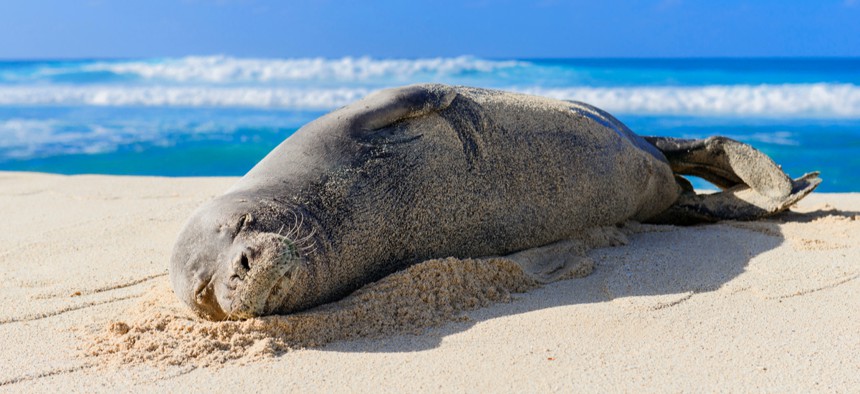Using Social Media to Monitor Endangered Species Uncovers Surprising Information

Monk seals are one of the most endangered populations of seals on the planet. Shutterstock

Connecting state and local government leaders
Federal researchers used Instagram to collect information on human interactions with endangered monk seals and found that the posts contained data that was missing from traditional reports.
Conservation officials in Hawaii do constant outreach to remind tourists and residents to give a wide berth to endangered species, but those efforts are no match for people on the hunt for the perfect selfie.
Or in this case, “seal-fie.”
That’s according to a recent study from the National Oceanic and Atmospheric Administration that sifted through 2,392 Instagram posts with the hashtag #monkseal to get a sense of how often people were interacting with the endangered mammals. The results showed that nearly 18 percent of posts showed signs of humans disturbing a seal, despite guidelines that recommend staying at least 50 feet away.
“I could not believe how many people were posting pictures of themselves so close to monk seals,” Mark Sullivan, the lead researcher, said in a statement. “For seal research and conservation activities, NOAA scientists obtain permits that allow them to disturb animals by accident, but I always duck and tiptoe around them. I wouldn’t be doing my job right if I didn’t work hard to avoid scaring them into the water.”
Monk seals are one of the most endangered seal populations in the world, with roughly 1,400 remaining in the wild, according to NOAA. They live exclusively in the Hawaiian islands, though only about 300 reside on the main islands, according to Megan McGinnis, the animal programs manager at the Marine Mammal Center in Hawaii, a conservation nonprofit.
“There has been about a 2 percent population increase in the past five-ish years,” she said. “Researchers have estimated that about 30 percent of the monk seals alive today are due to conservation efforts by NOAA and their partners.”
NOAA’s monitoring efforts include collecting sighting reports from the public. Non-emergency sightings are submitted by phone or email and ideally include the date and time of the sighting, the location, and details about the seal, including its behavior, size and any unusual markings. Those reports are helpful in determining where individual seals are at any given time, but researchers suspected that they may not fully describe human interactions with the animals. Instagram, they found, offered a more unvarnished look at those encounters.
Social media posts aren’t a comprehensive monitoring tool, researchers cautioned, as traditional reports contained better information on identifying markings and specific locations of seals. But the posts documented in real-time people’s interactions with monk seals, including clear signs of disturbance that were not indicated in other reports.
“We found that photos posted on Instagram were far more likely to capture disturbance or interactions as compared to traditional sightings reports,” the report said.
About 17.8 percent of posts reviewed for the study showed stress signs in the animals (moving away, looking away, opening mouths), while just .64 percent of traditional reports mentioned any type of disturbance. Those signs may seem subtle to someone who doesn’t study monk seals, McGinnis said, but are clear symptoms that the animal is being disturbed.
“Monk seals can haul out on the beach for hours,” she said. “They hunt in the evening, so when they decide to haul out, that’s their rest time. If people come over and they start looking up or they go back to the water, that is a definite sign of disturbance, because they spend a significant part of their day sleeping.”
Those instances may go unreported, researchers wrote, either because members of the public don’t know what signs to look for or don’t want to detail them.
“While many may lack the awareness or inclination to report a wildlife interaction or disturbance, photo-based social media provides the major benefit of recording interactions regardless of the awareness level of the participants, thus potentially removing a source of bias,” the study concludes. “The extremely low rate of disturbance reported by traditional means should be considered by wildlife managers to evaluate their system of capturing such data and setting management guidelines.”
Kate Elizabeth Queram is a Staff Correspondent for Route Fifty and is based in Washington, D.C.

NEXT STORY: Conflict Between Lawmakers Isn’t Always a Bad Thing




